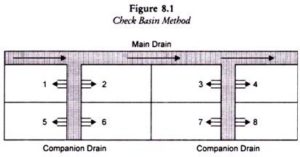In this method (check basin method), the whole field is divided into basins according to the capacity of water. Basins are connected through a ‘Dhora’ (A small drain type flow way), which has raised earthen walls on both sides. ‘Dhora’ is of two types, one is the main ‘Dhora’ and the other ‘Dhora’ is connected to basins. Size of basins are made according to the inflow of water.
These basins are surrounded by small furrows. Branch ‘Dhora’ flows towards the slope from the main ‘Dhora’. If the slope of branch ‘Dhora’ is steep, ‘mooonja’ or polythene is spread in it to prevent erosion of sides. The main source of water is located at the highest place in the field.

The width of drains is affected by factors like flow of water, percentage, slope and structure of the ground etc. The length of ‘Dhora’is different depending on the basis of slope and formation of the fields. This method is also prevalent in India as it does not cause any burden on the farmer.
This method has the following advantages:
1. It is the best method of irrigation for leveled fields.
2. It does not require any technical knowledge.
3. This method is more useful in soils having lesser infiltration.
4. In this method, rain water stays in basins, hence soil erosion is not caused.
5. It has lesser economic investment.
6. It irrigates more area.
7. Crops gets sufficient water.
Following are disadvantages of check basin method:
1. Due to seepage in drains, wastage of water is caused.
2. Machines cannot be used m this method because during spray of insecticides or fertilizers, the earthen walls of basins are damaged.
3. There IS imbalance in distribution of labour. After growth of crops, water reaches the basins in disproportionate quantity thereby causing wastage of water.
4. Creation of problem of water logging.
